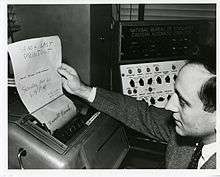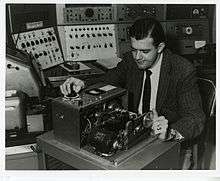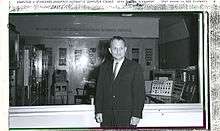SEAC (computer)


SEAC (Standards Eastern Automatic Computer[1] or Standards Electronic Automatic Computer)[2] was a first-generation electronic computer, built in 1950 by the U.S. National Bureau of Standards (NBS) and was initially called the National Bureau of Standards Interim Computer, because it was a small-scale computer designed to be built quickly and put into operation while the NBS waited for more powerful computers to be completed (the DYSEAC). The team that developed SEAC was organized by Samuel N. Alexander.[3] SEAC was demonstrated in April 1950 and in May 1950 it went into full production, making it the first fully functional stored-program electronic computer in the US.
Description
Based on EDVAC, SEAC used only 747 vacuum tubes (a small number for the time) eventually expanded to 1,500 tubes. It had 10,500 germanium diodes which performed all of the logic functions (see the article diode–transistor logic for the working principles of diode logic), later expanded to 16,000 diodes. It was the first computer to do most of its logic with solid-state devices. The tubes were used for amplification, inversion and storing information in dynamic flip-flops.[4] The machine used 64 acoustic delay lines to store 512 words of memory, with each word being 45 bits in size. The clock rate was kept low (1 MHz).
The computer's instruction set consisted of only 11 types of instructions: fixed-point addition, subtraction, multiplication, and division; comparison, and input & output. It eventually expanded to 16 instructions.
The addition time was 864 microseconds and the multiplication time was 2,980 microseconds (i.e. close to 3 milliseconds).
Applications
On some occasions SEAC was used by a remote teletype. This makes it one of the first computers to be used remotely. With many modifications, it was used until 1964. Some of the problems run on it dealt with:
- digital imaging, led by Russell A. Kirsch
- meteorology
- linear programming
- optical lenses
- a program for Los Alamos National Laboratory
- tables for LORAN navigation
- statistical sampling plans
- wave function of the helium atom
- designing a proton synchrotron
 SEAC block diagram
SEAC block diagram SEAC input/output diagram
SEAC input/output diagram Magnetic wire drives and cartridges
Magnetic wire drives and cartridges Offline magnetic wire to paper tape & print station
Offline magnetic wire to paper tape & print station SEAC scanner
SEAC scanner First image scanned into SEAC, son of Russell A. Kirsch
First image scanned into SEAC, son of Russell A. Kirsch Samuel N. Alexander with SEA
Samuel N. Alexander with SEA Horace Joseph and George A. Moore using the SEAC image scanner to analyze metallurgical photographs in 1960. Moore was legally blind.[5]
Horace Joseph and George A. Moore using the SEAC image scanner to analyze metallurgical photographs in 1960. Moore was legally blind.[5] SEAC wiring
SEAC wiring Ethel Marden at the control console of SEAC in 1959
Ethel Marden at the control console of SEAC in 1959
See also
- SWAC (Standards Western Automatic Computer)
- List of vacuum tube computers
- Manchester Small-Scale Experimental Machine
References
- ↑ http://www.computerhistory.org/timeline/?year=1950
- ↑ 1955 BRL report
- ↑ "Obituary: Samuel Alexander, NBS Senior Research Fellow". Physics Today. 21 (4): 131. April 1968. doi:10.1063/1.3034910.
- ↑ Glen G. Jr. Langdon (2012). Logic Design: A Review Of Theory And Practice. Elsevier. p. 7. ISBN 032316045X.
- ↑ Metallography--past, Present, and Future: 75th Anniversary Volume, Issue 1165, George F. Vander Voort, p.14
- Williams, Michael R. (1997). A History of Computing Technology. IEEE Computer Society.
- Metropolis, N; Howlett, J.; Rota, Gian-Carlo (editors) (1980). A History of Computing in the Twentieth Century. Academic Press. (The chapter "Memories of the Bureau of Standards' SEAC", by Ralph J. Slutz.)
- Astin, A. V. (1955), Computer Development (SEAC and DYSEAC) at the National Bureau of Standards, Washington D.C., National Bureau of Standards Circular 551, Issued January 25, 1955, U.S. Government Printing Office. Includes several papers describing SEAC, its technical details, and its operation. In particular, see "SEAC", by S. Greenwald, S. N. Alexander, and Ruth C. Haueter, on pp. 5–26, for an overview of the SEAC system.
External links
- SEAC and the Start of Image Processing at the National Bureau of Standards – At the NIST virtual museum
- Margaret R. Fox Papers, 1935-1976, Charles Babbage Institute, University of Minnesota. collection contains reports, including the original report on the ENIAC, UNIVAC, and many early in-house National Bureau of Standards (NBS) activity reports; memoranda on and histories of SEAC, SWAC, and DYSEAC; programming instructions for the UNIVAC, LARC, and MIDAC; patent evaluations and disclosures; system descriptions; speeches and articles written by Margaret Fox's colleagues; and correspondence of Samuel Alexander, Margaret Fox, and Samuel Williams. Boxes 6-8 of the Fox papers contain documents, reports, and analysis of the NBS's SEAC.
- SEAC ("Standards Eastern Automatic Computer") (1950), from History of Computing: An Encyclopedia of the People and Machines that Made Computer History, Lexikon Services Publishing
- Timeline of Computer History at CHM
| Wikimedia Commons has media related to SEAC computer. |